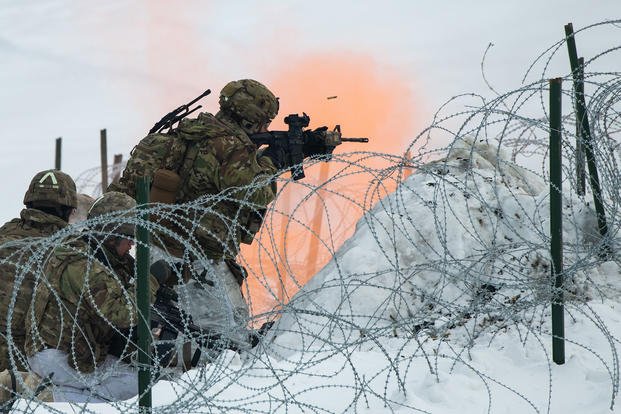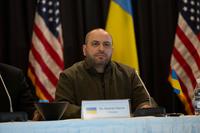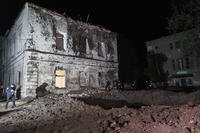The Army redesignated its Alaska force as the 11th Airborne Division in the summer of 2022, with top brass hoping the rebranding would be part of a shift toward a prestigious fighting force -- the so-called tip of the spear in the Pacific.
But a year later, soldiers are reporting sexual harassment and a raft of other problems.
An internal Army assessment conducted in recent weeks on the 2nd Infantry Brigade Combat Team, 11th Airborne Division, that was reviewed by Military.com also found a culture of inappropriate joking and behavior that included sexist or racist remarks, evidence of rampant alcohol abuse, and a pace of training missions that was overwhelming leaders and junior soldiers.
Read Next: Will Congress Protect Troop Pay if the Government Shuts Down Sunday? For Now, That's Unclear
The Army's relatively new Cohesion Assistance Team, or CAT, produced the review. That team is tasked with reviewing the culture of units by pulling data such as retention rates, reviewing command climate surveys, and conducting surveys and interviews with soldiers in groups and one-on-one, as well as providing plans to commanders to address any issues that are found. The teams were previously known as Cohesion Assessment Teams.
The findings show that the brigade is struggling with many of the same issues found in units across the Army, with some problems such as drinking and high-tempo operations being exacerbated by its location in Alaska.
Soldiers in the brigade said they believed in an "acceptable" level of sexual harassment and unwanted touching, according to the CAT.
The CAT interviews also found that over a two-week period:
- 3% of the soldiers reported being offered a reward or special treatment for sexual favors.
- 5% said they experienced catcalling, ogling or leering in ways that made them uncomfortable.
- 6% of soldiers said they experienced unwanted touching.
It was unclear how many total soldiers were interviewed or surveyed in the brigade of roughly 4,000 troops.
The brigade had an inconsistent vetting process for personnel in its Army Sexual Harassment and Assault Response and Prevention program, or SHARP, as well as equal opportunity positions. Those positions, the review found, were being advertised as a means for career advancement. The qualifications are often significant highlights in career evaluation reports.
One anonymous comment from a senior leader in the survey said, "SHARP training is a joke." A junior soldier said, "I do not feel safe in the barracks."
Meanwhile, of the troops surveyed, 16% reported witnessing racist comments about them or another soldier. Half of that group said the comments involved a person in a higher rank or position of authority.
Excessive drinking was also a concern uncovered by the review, especially in Alaska where weather and geography often limit options when troops aren't on duty.
"The boys and girls in the barracks, what else is there to do on a Friday night other than hunker down and get wasted," one junior noncommissioned officer said in an anonymous comment on the survey.
The frantic training schedule of the Alaska brigade was also leading to a poor work-life balance among soldiers. Those findings were consistent with findings from Military.com in interviews with soldiers in the division, with many of them expressing concerns over the constant time in the field, rotations abroad and other training, such as achieving expert badges.
The CAT reviews are typically intended to stay internal to the unit to avoid the perception they are designed to be punitive. That team and its audit are separate from inspector general and 15-6 investigations, and are focused on organizations not individual leaders.
The process was spurred by the slaying of Spc. Vanessa Guillén at Fort Cavazos, Texas, in 2020 and is a part of several Army efforts to improve its culture. The CAT includes a lieutenant colonel, multiple senior noncommissioned officers, behavioral health professionals, legal officials and a chaplain, among other experts in fields such as health care.
John Pennell, an 11th Airborne Division spokesman, said the assessment was meant to ensure soldiers had a way to express concerns about unit cohesion and voice suggestions for improvement.
"As always, our soldiers and leaders have provided unfiltered feedback addressing issues within the brigade, some we have been aware of, and others we may have missed," Pennell said in a statement to Military.com. "The true value of these types of surveys is hearing directly from our teammates as we strive to create a strong climate of compassionate leadership that all our soldiers want and deserve while we meet the mission of providing the American people a trained and ready Arctic force.
"This is how we take ownership and responsibility as leaders," he said.
One company-level officer told Military.com, on the condition of anonymity because they were not authorized to talk to the press, that his unit's field time has been virtually nonstop for over a year and that he hasn't been home for more than a few weeks at any point.
Soldiers and leadership across the Army have raised the alarm over an unmanageable cadence of missions and training, but those issues can be compounded in Alaska where the temperatures hit -65 degrees, causing the daily grind seen in other units to wear on soldiers more quickly.
"Have I seen [culture] issues? Yeah, and this needs stomped out ... but the typical Army issues, they're more intense here by nature of the environment," one infantry platoon sergeant in the brigade told Military.com on the condition of anonymity to avoid retaliation.
"The training has become unmanageable," the NCO said.
The brigade's struggles with mission tempo are likely not unique to the 11th Airborne Division.
A Military.com review of internal service data in April showed roughly 120,000 soldiers were deployed abroad. For comparison, 187,900 troops, across all branches, were serving in Afghanistan and Iraq in 2008 when those two conflicts hit a crescendo.
And during the peak of the Global War on Terror, the Army was about 70,000 soldiers larger -- meaning a smaller Army is taking on a mission burden rivaling that of the entire military in the late 2000s and early 2010s.
Those overseas missions are on top of time away from home when service members are back at their duty station, including attending schools critical for promotion, typical field training and Combat Training Center, or CTC, rotations.
For the 11th Airborne Division this year, both of its brigades have done prolonged training exercises in the field. They trained in Malaysia, Japan and Australia, as well as supported Reserve Officers' Training Corps, or ROTC, in the lower 48 states.
-- Steve Beynon can be reached at Steve.Beynon@military.com. Follow him on X @StevenBeynon.













